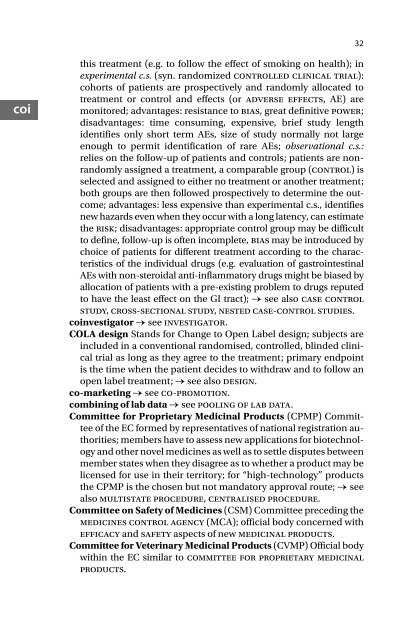220-Dictionary of Pharmaceutical Medicine, 2nd Edition-Gerhard Nahler Annette Mollet-3211898352-S
220-Dictionary of Pharmaceutical Medicine, 2nd Edition-Gerhard Nahler Annette Mollet-3211898352-S
220-Dictionary of Pharmaceutical Medicine, 2nd Edition-Gerhard Nahler Annette Mollet-3211898352-S
Create successful ePaper yourself
Turn your PDF publications into a flip-book with our unique Google optimized e-Paper software.
32coithis treatment (e.g. to follow the effect <strong>of</strong> smoking on health); inexperimental c.s. (syn. randomized controlled clinical trial):cohorts <strong>of</strong> patients are prospectively and randomly allocated totreatment or control and effects (or adverse effects, AE) aremonitored; advantages: resistance to bias, great definitive power;disadvantages: time consuming, expensive, brief study lengthidentifies only short term AEs, size <strong>of</strong> study normally not largeenough to permit identification <strong>of</strong> rare AEs; observational c.s.:relies on the follow-up <strong>of</strong> patients and controls; patients are nonrandomlyassigned a treatment, a comparable group (control) isselected and assigned to either no treatment or another treatment;both groups are then followed prospectively to determine the outcome;advantages: less expensive than experimental c.s., identifiesnew hazards even when they occur with a long latency, can estimatethe risk; disadvantages: appropriate control group may be difficultto define, follow-up is <strong>of</strong>ten incomplete, bias may be introduced bychoice <strong>of</strong> patients for different treatment according to the characteristics<strong>of</strong> the individual drugs (e.g. evaluation <strong>of</strong> gastrointestinalAEs with non-steroidal anti-inflammatory drugs might be biased byallocation <strong>of</strong> patients with a pre-existing problem to drugs reputedto have the least effect on the GI tract); → see also case controlstudy, cross-sectional study, nested case-control studies.coinvestigator → see investigator.COLA design Stands for Change to Open Label design; subjects areincluded in a conventional randomised, controlled, blinded clinicaltrial as long as they agree to the treatment; primary endpointis the time when the patient decides to withdraw and to follow anopen label treatment; → see also design.co-marketing → see co-promotion.combining <strong>of</strong> lab data → see pooling <strong>of</strong> lab data.Committee for Proprietary Medicinal Products (CPMP) Committee<strong>of</strong> the EC formed by representatives <strong>of</strong> national registration authorities;members have to assess new applications for biotechnologyand other novel medicines as well as to settle disputes betweenmember states when they disagree as to whether a product may belicensed for use in their territory; for “high-technology” productsthe CPMP is the chosen but not mandatory approval route; → seealso multistate procedure, centralised procedure.Committee on Safety <strong>of</strong> <strong>Medicine</strong>s (CSM) Committee preceding themedicines control agency (MCA); <strong>of</strong>ficial body concerned withefficacy and safety aspects <strong>of</strong> new medicinal products.Committee for Veterinary Medicinal Products (CVMP) Official bodywithin the EC similar to committee for proprietary medicinalproducts.


